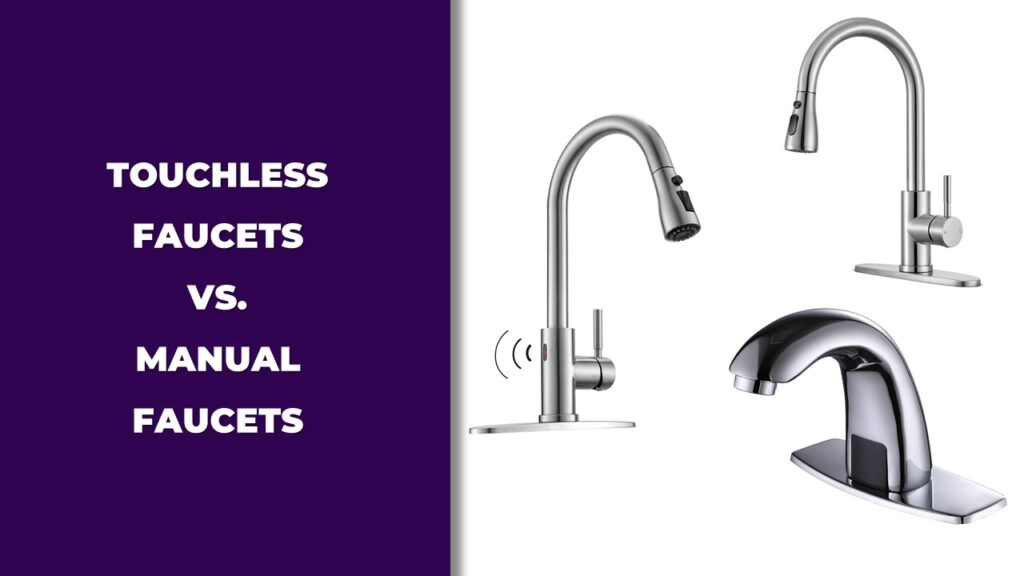
The main difference between touchless faucets and manual faucets is how they’re operated. Touchless faucets use motion sensors to turn water on and off without needing contact, which makes them more hygienic and water-efficient. Manual faucets require physical touch to adjust the handle or knob, giving you direct control over water flow and temperature but exposing the surface to more germs and possible water waste.
In this article, we’ll break down how each faucet works, where they perform best, and what to expect in terms of installation, maintenance, cost, and long-term value. You’ll also learn when it makes sense to choose one over the other based on your household’s needs.
What Is a Manual Faucet and How Does It Work?
A manual faucet is a traditional faucet that you turn on and off by hand, usually with a handle or a knob. You control both the water flow and the temperature by physically adjusting the handle.
This type of faucet is what most of us grew up using. It’s simple, reliable, and doesn’t need any batteries or power source to work. You just turn the handle, and the water flows. Want hot water? Turn the hot side. Want cold? Turn the cold side. It’s that straightforward.
Manual faucets come in a few different styles. Some have one single lever that controls both hot and cold water, while others have two separate knobs. They’re common in both kitchens and bathrooms and are usually easy to install or replace without needing a professional. Many people still prefer them for their control and simplicity.
What Is a Touchless Faucet and How Does It Work?
A touchless faucet uses a motion sensor to turn the water on and off, so you don’t have to touch it at all. When your hands move near the sensor, the water starts flowing automatically.
These faucets are powered by batteries or a plug-in power source and are designed to make things cleaner and more convenient. You’ll often see them in public restrooms, but they’re becoming popular at home too. They’re especially helpful when your hands are dirty, full of soap, or covered in dough from cooking. You can wash up without touching anything and making a mess.
Inside the faucet, there’s usually an infrared sensor that picks up motion. Once it senses movement, it triggers a valve to let the water flow. When the sensor no longer detects movement, it turns the water off. It’s a great hands-free way to save water and keep your sink area cleaner.
Key Differences Between Touchless Faucets And Manual Faucets
The key differences between touchless faucets and manual faucets come down to how they operate, how much control you have, and how they affect your water usage and budget over time. Here’s a quick look:
- Touchless faucets use motion sensors. Manual faucets need hands-on turning.
- Touchless options improve hygiene by reducing contact.
- Automatic shut-off features help save water and money.
- Maual faucets are more affordable upfront and don’t require power.
- Installation and maintenance needs vary between the two.
Now, let’s break these down one by one to help you make a smart and confident choice.
Activation
Manual faucets need you to physically move a handle, turn a knob, or lift a lever. It’s simple and works well, but not always the most convenient when your hands are sticky, soapy, or full.
Touchless faucets come with built-in sensors. Just move your hand in front of it, and the water flows. No need to touch a thing. It’s especially helpful when you’re cooking or helping a messy toddler wash up. They feel effortless once you get used to them.
Hygiene
Touchless faucets cut down the spread of germs. Since there’s no need to touch the handle before or after washing, fewer germs transfer from dirty hands to the faucet. This is helpful during flu season or in shared spaces like family bathrooms or kitchens prone to hard water buildup, where constant cleaning is already a chore.
With manual faucets, you always touch the handle to turn it on and off. So if your hands are covered in raw chicken juice or paint, you’re leaving that behind for the next person. That also means more frequent cleaning.
Water Conservation
Touchless faucets usually shut off automatically after a few seconds. That means less water goes down the drain while brushing your teeth or walking away mid-use. On average, a touchless faucet can save around 700 gallons per year.
That may sound small, but over time, it adds up. At an average rate of $0.002 per gallon, that’s $1.40 saved per faucet, per year. If you have two or three faucets in your home, and you live there for 10 years, that’s over $40 saved without changing any habits.
Manual faucets leave water conservation in your hands. If someone forgets to turn it off or leaves it running while multitasking, water gets wasted, and your bill increases.
Power Source
Manual faucets don’t need power. They work using basic plumbing pressure and mechanical parts. That means no wires, no batteries, and no extra things to worry about.
Touchless faucets need a power source to operate. Most models run on 4 AA batteries or plug into a standard power outlet. The batteries typically last 6 to 24 months, depending on use. A pack of batteries costs around $4 to $6, and replacing them once or twice a year means spending about $8 to $12 annually per faucet.
Some advanced models offer dual power setups with both battery and plug options, so you’re not left stuck if one fails.
Cost
Manual faucets usually cost less upfront. A decent model may run between $50 to $150, depending on design and materials. They’re easy to find, install, and maintain.
Touchless faucets start at around $150 and can go beyond $300 for high-end kitchen faucet models with added features. Installation could cost another $100 to $200 if you hire a plumber. That makes the upfront cost higher, but some of it may balance out over time through reduced water use and convenience.
Flow And Temperature Control
Manual faucets let you fine-tune the flow and temperature. Whether you like a steady stream or a light trickle, hot water or cold, you control it with the handle. Most residential faucets deliver between 1.5 to 2.2 gallons per minute (GPM).
Touchless faucets often come with a preset flow rate, usually around 1.5 GPM, to encourage water savings. Some let you adjust it slightly, but many are fixed. For temperature control, some models include a manual mixing valve or a side handle. Others need the temperature set during installation.
If you’re someone who likes to adjust things often, manual faucets give you that flexibility.
Installation And Maintenance
Manual faucets are generally DIY-friendly. Most come with clear instructions, and if you’ve got basic tools and a bit of time, it’s a doable project.
Touchless faucets are more technical. You’ll be dealing with sensor placement, battery compartments, and sometimes control boxes. Some brands make it easy, but others are best handled by a professional.
Maintenance is a little different too. Manual faucets may need a washer replaced, or you might deal with things like a faucet dripping at night or worn seals every few years. Touchless ones might need new batteries, sensor cleanings, or the occasional solenoid valve replacement.
Touchless Faucets Vs. Manual Faucets: Quick Comparison Table
If you’re weighing your options between a manual faucet and a touchless one, this table sums up the key differences in a clear and practical way. Whether you’re prioritizing activation method, hygiene, water efficiency, or looking at things like power source, cost, flow control, and installation, it helps to see how they stack up.
Whether you’re after convenience, control, or cost-efficiency, this side-by-side breakdown helps you see the full picture.
| Feature | Manual Faucet | Touchless Faucet |
| Activation | Requires touch (handle or knob) | Motion-sensor based (hands-free) |
| Hygiene | Higher contamination risk | No-touch reduces germ spread |
| Water Efficiency | Depends on habits, up to 2.2 GPM | Auto shut-off saves up to 700 gallons/year (~$1.40/faucet) |
| Power Source | None | 4 AA batteries (lasts 6–24 months), or AC adapter |
| Cost | $50–$150 (basic to mid-range) | $150–$350 (plus $8–$12/year for batteries) |
| Flow Control | Fully adjustable (1.5–2.2 GPM typical) | Often fixed at 1.5 GPM, some allow adjustments |
| Installation | DIY-friendly, takes 30–60 minutes | May need a professional, more complex setup |
Pros And Cons Of Touchless Faucets
Touchless faucets offer hands-free operation, better hygiene, and water-saving features, but they require a power source and can cost more to buy and install. They’re ideal for busy households that value convenience and cleanliness.
Now let’s take a closer look at where they shine and where they may fall short.
Pros
- Touch-Free For Better Hygiene: Since you don’t have to touch the faucet, there’s less chance of spreading bacteria from dirty hands. This is especially helpful in kitchens where cross-contamination is a concern, or in bathrooms shared by many people. It’s also a smart option during flu season or in homes with toddlers and seniors.
- Conserves Water With Auto Shut-Off: Most touchless faucets come with built-in shut-off timers. They stop water flow when not in use, preventing waste. On average, this can save up to 700 gallons of water per year, which adds up over time on your utility bill.
- Great For Kids, Elderly, And Modern Homes: Kids often forget to turn faucets off, and older adults might struggle with tight knobs or stiff handles. Touchless models make things easier for both. Plus, their sleek design fits right into modern or minimalist spaces.
Cons
- Needs Power Or Batteries: Unlike manual faucets, these rely on electricity. Most use batteries, which need changing once or twice a year. Some plug into an outlet. If the power source fails, the faucet won’t work unless it has a manual override.
- Sensor Issues May Occur: Sensors can sometimes miss the motion or activate unintentionally. Water might not flow when you expect it to, or it might turn on when no one’s using it. This depends on sensor quality and placement.
- Higher Purchase And Installation Cost: A good touchless faucet can cost between $150 to $350. If you hire a plumber for installation, it may cost another $100 to $200. While some of this may balance out with long-term savings, the upfront cost is higher than traditional faucets.
Pros And Cons Of Manual Faucets
Manual faucets are simple, affordable, and give you full control over water flow and temperature. But they can waste water if left on and are less hygienic since they require touch.
Here’s how the pros and cons compare in daily use.
Pros
- Simple And Reliable: Manual faucets have fewer moving parts and no electronic components. They’re easy to operate and rarely fail. You can expect consistent performance for years with basic maintenance.
- No Need For Electricity: These faucets run purely on water pressure. That means they work during power outages and don’t need battery replacements. Fewer moving parts also means fewer things to break down.
- Full Flow and Temperature Control: You can fine-tune the temperature and flow exactly as you like it. Whether it’s a slow trickle for watering plants or a strong stream for washing dishes, manual faucets give you that flexibility.
Cons
- Touch Spreads Bacteria: You have to touch the handle before and after washing, which increases the chance of transferring germs. This can be a concern in shared spaces or when handling raw meat or messy ingredients.
- Risk of Water Being Left On: Manual faucets rely entirely on user behavior. If someone forgets to turn it off or leaves it running too long, water gets wasted. Over time, this can lead to higher water bills and unnecessary waste.
When To Choose Touchless Faucets Over Manual Ones
Choose a touchless faucet when hygiene, convenience, and water efficiency are top priorities. These faucets are perfect for homes with kids, elderly family members, or anyone who values a hands-free experience in the kitchen or bathroom.
If your household deals with a lot of cooking, messy hands, or shared bathroom use, a touchless faucet can really simplify daily routines. You won’t have to clean handles as often, and you’ll use less water without even trying. It’s especially helpful in situations where germs can spread easily, such as during flu season or in high-traffic bathrooms.
Families with children or seniors often find touchless faucets easier to manage. No twisting, gripping, or turning. Just wave a hand to start the water. That’s a big deal if someone has limited mobility or arthritis. It also reduces the chance of forgetting to turn off the faucet, helping avoid unnecessary water waste.
Touchless faucets also match well with modern, tech-forward homes. If your space is already full of smart gadgets, it makes sense to upgrade your faucet too. Some high-end models even let you adjust settings through apps or pair with smart home systems.
When Manual Faucets Might Be The Better Option
Manual faucets are a better choice when budget, simplicity, and hands-on control matter most. They cost less upfront, don’t require power, and are easy to install and maintain.
If you live in an area with frequent power outages, manual faucets are the safer option. You’ll never have to worry about dead batteries or sensors failing. They work anytime, as long as there’s water pressure. That peace of mind can make a big difference in some households.
Manual faucets also make sense for people who prefer full control over water flow and temperature. With a single twist, you can get the exact pressure or warmth you want. Touchless models don’t always offer that level of precision.
Finally, if you’re doing a budget remodel or need to replace an old faucet quickly, a manual model gets the job done without extra complications. You won’t need to deal with wiring or call in a plumber unless your setup is unusually tricky. For many homeowners, that makes manual the smarter move.
Final Thoughts: Which Faucet Is Right For You?
If hygiene, water savings, and hands-free control are priorities in your home, a touchless faucet is likely the better option. It works well in kitchens where your hands are often messy or in shared bathrooms where reducing germs matters.
On the other hand, if you want simple installation, full control over flow and temperature, and no reliance on power or sensors, a manual faucet makes more sense. It’s dependable, budget-friendly, and works anytime you need it, even if you’re dealing with faucet aerator clogs or low water pressure.
For families with kids or elderly members, touchless faucets can help prevent water waste and make daily routines easier. But in areas with frequent power outages or limited budgets, manual faucets remain the more practical choice.
Your decision should match how you live and use your space. Consider who’s using the sink, how often, and what trade-offs you’re willing to make between convenience and control.
Related FAQs
Do Touchless Faucets Work During Power Outages?
Battery-powered models will still work during power outages. Plug-in versions will stop working unless they have a manual override.
Can Touchless Faucets Fit All Sink Styles?
Most touchless faucets are compatible with standard sink hole setups. Always check the mounting type and spacing before buying.
How Often Do Batteries Need Replacing?
Touchless faucets typically need new batteries every 6 to 24 months, depending on usage and sensor quality.
Can They Be Used Manually If The Sensor Fails?
Some touchless models include a manual override switch or handle for backup operation if the sensor stops working.
Are They Harder To Clean Or Maintain?
No. They clean just like manual faucets. You may need to occasionally wipe the sensor and replace batteries.

Dylan Foster is a family man with years of hands-on experience in plumbing, household maintenance, and fixing everyday issues around the home. A former plumber, Dylan knows what it’s like to deal with tricky leaks, worn-out parts, and all the little problems that pop up in a house. From plumbing repairs to kitchen fixes and garden hose setups, he’s done it all. Dylan shares real-world solutions to help others keep their homes running smoothly and avoid costly mistakes.




